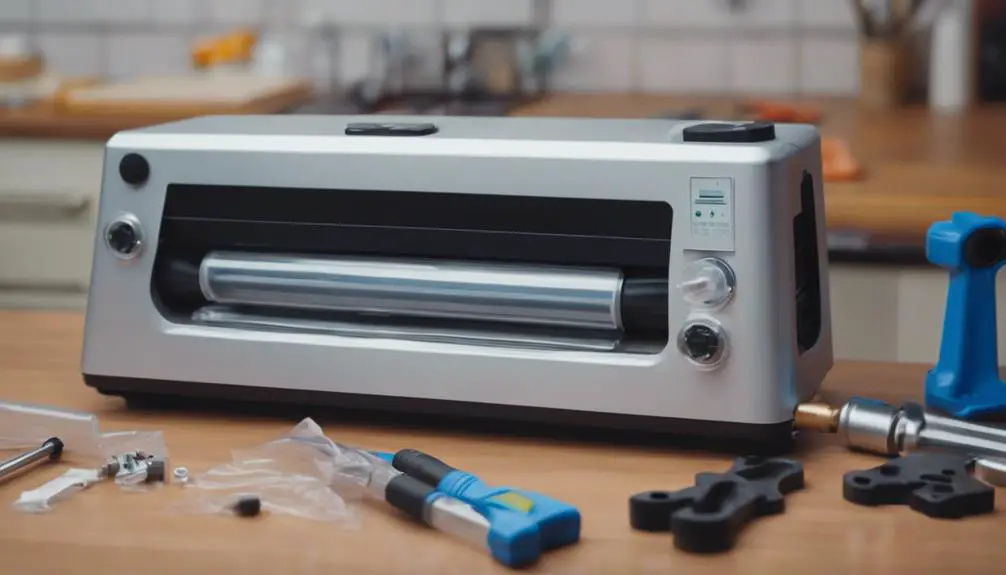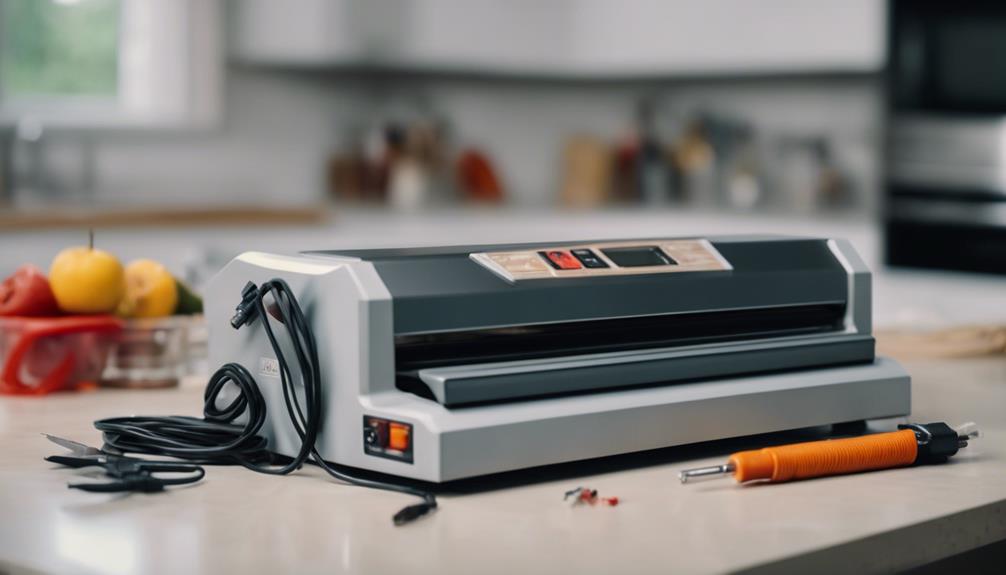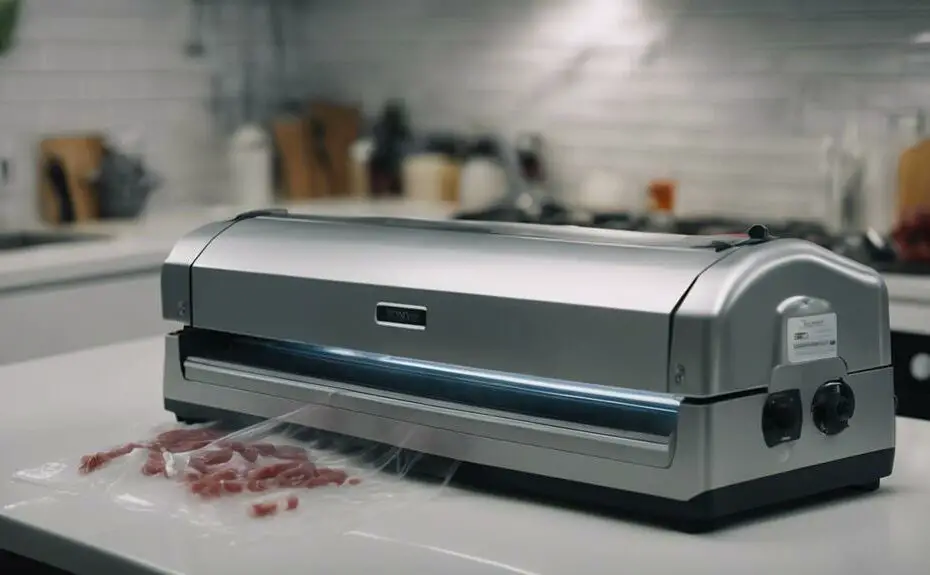Maintaining a vacuum sealer is crucial for its optimal performance. By understanding the device's intricacies, you can ensure that it remains a reliable ally in your culinary adventures. Let's explore the three common reasons why vacuum sealers fail and how to fix them.
One common issue is the loss of suction power. This can happen due to a variety of reasons, such as a worn-out gasket or a clogged air channel. To troubleshoot this problem, start by examining the gasket. If it appears damaged or worn, replace it with a new one. Additionally, check the air channel for any blockages. Clearing any debris or buildup can help restore the suction power of your vacuum sealer.
Another common problem is ineffective sealing. If you find that your vacuum sealer is not sealing properly, it could be due to an incorrect seal temperature. To fix this, try recalibrating the seal temperature. Follow the manufacturer's instructions to adjust the temperature settings to the recommended level for the type of food you are sealing. This should improve the effectiveness of the sealing process.
Electrical issues can also cause vacuum sealers to fail. If your vacuum sealer is not turning on or experiencing power fluctuations, there are a few steps you can take. First, check the power cord for any signs of damage. If you notice any frayed wires or exposed insulation, replace the cord immediately. Additionally, make sure the power outlet you are using is functioning properly. Try plugging in another device to see if it works. If the outlet is faulty, have it repaired or use a different outlet.
In conclusion, maintaining a vacuum sealer is essential for its longevity and efficiency. Loss of suction power, ineffective sealing, and electrical issues are common problems that can be fixed with a little troubleshooting. By examining gaskets, recalibrating seal temperatures, and checking for electrical issues, you can keep your vacuum sealer in top-notch condition and continue to enjoy the benefits of preserving food at its peak.
Loss of Suction Power

Losing suction power is a frustrating problem that can really hinder the effectiveness of vacuum sealers. I've encountered this issue before and it can leave you scratching your head and worrying about the preservation of your food. After delving into the mechanics of vacuum sealers, I discovered a few common causes for this problem.
One of the main culprits is a clogged air filter. Over time, debris and small particles can build up in the filter, blocking the airflow and significantly reducing the machine's efficiency. To avoid this, it's important to regularly clean or replace the air filter to ensure optimal performance.
Another issue that can lead to a loss of suction power is a faulty vacuum hose. If the hose isn't securely connected or has developed cracks, air will leak out and the sealer won't be able to maintain the necessary vacuum. To prevent this, it's a good idea to regularly inspect the hose for any damage and make sure it's tightly fitted.
Wear and tear on the seals can also be a culprit. These seals play a crucial role in creating an airtight environment, and when they start to degrade, they can't seal off the vacuum chamber effectively, resulting in decreased suction power. If you notice any signs of wear on the seals, it's important to replace them as soon as possible to restore your vacuum sealer's optimum performance.
In my experience, addressing these issues promptly and regularly maintaining your vacuum sealer can make a big difference in preventing the loss of suction power. By keeping the air filter clean, ensuring the vacuum hose is in good condition, and replacing worn seals, you can enjoy the full benefits of your vacuum sealer and confidently preserve your food.
Ineffective Sealing
Ineffective Sealing
One major challenge I've encountered with vacuum sealers is when they don't create an airtight seal, which directly impacts the freshness and longevity of food. It can be frustrating to put in all the effort and rely on the machine's capabilities, only to have the seal fail. There are several reasons why this can happen, but I've identified four primary causes:
- Worn Sealing Gaskets: Over time, the rubber gaskets that are responsible for creating a tight seal can wear out and become less effective. It's important to regularly inspect and replace these gaskets to ensure optimal sealing performance.
- Improper Bag Placement: If the bag isn't properly aligned within the sealer, it won't seal correctly. To address this, I always make sure the bag is straight and fully placed within the sealing chamber to ensure a proper seal.
- Residual Moisture or Food Particles: Any moisture or small bits of food left on the sealing edge can prevent a complete seal. To avoid this issue, I've learned to always wipe the edges clean before sealing to ensure a tight and effective seal.
- Heat Sealing Strip Issues: The heat strip plays a critical role in melting the bag to create a seal. Any damage or residue on the heat strip can impede the sealing process. It's important to regularly clean and check for any signs of wear to ensure optimal performance.
Electrical Issues

Electrical problems can be a major headache when it comes to vacuum sealing. These issues can completely halt the sealing process, making it crucial to address them promptly. Let's take a closer look at some common electrical problems and how to tackle them.
Power failures are a frequent culprit when it comes to vacuum sealer issues. To troubleshoot this, start by checking the machine's power cord and outlet for any signs of damage or wear. If you notice a frayed cord, it's essential to replace it to ensure a stable power supply. Additionally, check if the circuit breaker has tripped and needs to be reset. By taking these simple steps, you can often resolve power-related problems and get back to sealing.
Another electrical issue that can arise is a malfunctioning control panel. If you notice that the vacuum sealer's indicators or buttons aren't functioning correctly, it could indicate internal wiring problems. To address this, carefully open the unit and inspect the connections. Look for any loose or corroded wires that may need reattaching or replacing. However, it's crucial to exercise caution and have a certain level of technical skill when handling internal wiring.
Addressing these electrical issues promptly can save you a lot of time and frustration in the long run. By understanding the electrical components of your vacuum sealer, you can become more adept at troubleshooting and maintaining optimal performance.
When it comes to choosing a vacuum sealer, consider models that have a reputation for reliable electrical performance. Look for machines with sturdy power cords and outlets that are less prone to wear and tear. Additionally, opt for vacuum sealers with control panels that have a solid track record of durability and functionality.
Frequently Asked Questions
How Can Humidity or Temperature Variations in the Room Affect the Performance of a Vacuum Sealer?
Humidity and temperature variations in the room can significantly impact the performance of a vacuum sealer. When the humidity is high or the temperature is extreme, it can interfere with the seal integrity of the vacuum sealer, leading to seal failures. This is a crucial factor to consider, as maintaining stable room conditions is essential for achieving optimal performance with your vacuum sealer.
To ensure the effectiveness of your vacuum sealer, it is important to understand how humidity and temperature affect its performance. High humidity levels can cause moisture to accumulate in the sealing area, preventing the vacuum sealer from creating a proper seal. On the other hand, extreme temperatures can affect the adhesive properties of the sealing material, making it less effective in creating a secure seal.
By keeping the room conditions stable, you can overcome these challenges and enhance the performance of your vacuum sealer. Here are some practical tips to consider:
- Control the humidity: Use a dehumidifier in the room where you operate the vacuum sealer to maintain a low humidity level. This will help prevent moisture buildup and ensure a strong seal.
- Maintain optimal temperature: Keep the room temperature within the recommended range for your vacuum sealer. Extreme heat or cold can compromise the effectiveness of the sealing process. If necessary, use a room heater or air conditioner to regulate the temperature.
- Choose a reliable vacuum sealer: Invest in a high-quality vacuum sealer that is designed to withstand varying humidity and temperature conditions. Look for models that feature moisture-resistant seals and temperature-resistant sealing materials.
- Store your vacuum sealer properly: When not in use, store your vacuum sealer in a clean and dry environment. Avoid exposing it to excessive humidity or extreme temperatures, as this can damage its components and affect its performance.
Can Using Different Brands or Types of Vacuum Sealer Bags Than What's Recommended Cause Long-Term Damage to the Machine?
Yes, using off-brand or incompatible vacuum sealer bags can damage your machine over time. It puts unnecessary strain on the appliance, which can lead to overheating or even malfunction. To avoid these issues, it is always best to stick to the bags recommended by the manufacturer.
Using the correct bags ensures optimal performance and longevity for your vacuum sealer. These bags are designed to work seamlessly with your machine, providing a tight seal and efficient vacuuming. They are made from high-quality materials that can withstand the sealing process without causing any damage.
When you use off-brand or incompatible bags, you run the risk of them not fitting properly in the machine. This can result in air leaks, which can compromise the vacuuming process. In turn, this may require you to run the machine for longer periods or use higher settings, which can put additional strain on the motor and heating elements.
To give you a specific example, let's say you have a FoodSaver vacuum sealer. FoodSaver recommends using their branded bags for optimal performance. These bags are made with a multi-layer construction that provides excellent durability and a strong seal. Using other bags that don't meet these specifications may not provide the same level of quality and could potentially harm your machine in the long run.
How Does the Frequency of Use Impact the Lifespan of a Vacuum Sealer?
Using a vacuum sealer sparingly doesn't guarantee that it will last forever, which may seem ironic. In fact, frequent use can actually wear it down, just like any other appliance. However, it's important to find the right balance between maintenance and moderate usage in order to extend its lifespan, rather than avoiding using it altogether.
When it comes to maintaining a vacuum sealer, there are a few key things to keep in mind. First and foremost, it's important to clean the machine regularly. This includes wiping down the exterior, as well as cleaning out any food particles or debris that may have accumulated inside. Additionally, it's a good idea to inspect the sealing strip periodically and replace it if necessary, as a worn-out strip can lead to less effective sealing.
In terms of usage, it's important to be mindful of how often and for what purposes you are using the vacuum sealer. While it's great for preserving food and extending its shelf life, excessive use can put strain on the machine and shorten its lifespan. It's best to use the vacuum sealer when needed, but not to excess.
One way to reduce wear and tear on your vacuum sealer is to invest in high-quality vacuum bags. These bags are designed to withstand the vacuuming and sealing process without tearing or puncturing. By using durable bags, you can minimize the risk of damaging the machine and ensure that it continues to function properly for longer.
Another tip is to give your vacuum sealer some rest between uses. This allows the machine to cool down and prevents overheating, which can be detrimental to its longevity. If you find yourself using the vacuum sealer for extended periods of time, consider taking breaks in between sealing sessions to give the machine a chance to rest.
Are There Any Specific Maintenance Routines Recommended for Vacuum Sealers That Are Not Used Regularly?
Performing regular maintenance on vacuum sealers that are not used frequently is essential to ensure their optimal performance. Here are some recommended maintenance routines:
- Cleaning the sealing bar and gaskets: Over time, dust, debris, and food particles can accumulate on the sealing bar and gaskets, affecting the quality of the seal. Use a mild detergent or vinegar solution to clean these components. Gently scrub the surfaces with a soft brush or cloth, ensuring all residue is removed. Rinse thoroughly and allow to dry completely before using the sealer again.
- Checking for wear: Periodically inspect the sealing bar and gaskets for any signs of wear or damage. Look out for cracks, tears, or uneven surfaces that could compromise the sealing process. If you notice any issues, replace the worn-out parts promptly to maintain the vacuum sealer's efficiency.
- Running a sealing cycle monthly: Even if the vacuum sealer is not used regularly, it's important to run a sealing cycle at least once a month. This helps keep the internal mechanisms lubricated and prevents them from becoming stiff or jammed. Simply place a bag or a piece of plastic film in the sealer, close the lid, and run the sealing cycle without vacuuming. This routine maintenance will help ensure that the vacuum sealer operates smoothly when you need it.
Can Overfilling Bags Beyond Their Capacity Lead to Permanent Damage or Reduced Effectiveness in Vacuum Sealers?
When you overfill bags beyond their capacity in a vacuum sealer, it's like trying to cram too much into a suitcase. It puts strain on the seams and can actually damage the vacuum sealer over time. This can result in reduced effectiveness and even permanent damage.
It's important to respect the bag's capacity and not exceed it. By doing so, you can ensure the longevity and efficiency of your vacuum sealer. Overfilling the bags puts unnecessary stress on the machine and can lead to problems down the line.
To avoid this, make sure to read the instructions and guidelines provided by the manufacturer. They will usually specify the maximum capacity for the bags. It's always better to err on the side of caution and not push the limits.
In addition to preventing damage, properly filling the bags also ensures that the vacuum sealer works effectively. When the bags are properly filled, the air can be removed more efficiently, resulting in a better seal and longer shelf life for your food.
If you're unsure about how much to fill the bags, you can always start with a smaller amount and gradually increase it until you reach the maximum capacity. It's better to be safe than sorry.
Conclusion
When it comes to vacuum sealers, it's not uncommon to encounter a few issues along the way. However, with the right knowledge and fixes, we can turn these problems into mere inconveniences. Let's explore three common reasons why vacuum sealers fail and how we can address them.
Firstly, loss of suction power can be a frustrating problem. After all, the whole point of using a vacuum sealer is to remove air and create an airtight seal. One possible cause for this issue is a dirty or worn-out gasket. Over time, the gasket can accumulate debris or become worn, compromising its ability to create a tight seal. To fix this, simply clean the gasket thoroughly and replace it if necessary. Additionally, make sure the sealing strip is clean and free from any residue that could hinder the sealing process.
Another common problem is ineffective sealing. If you find that your vacuum sealer isn't creating a proper seal, there are a few things you can check. First, ensure that the bag is placed correctly in the sealer and that there are no wrinkles or folds in the sealing area. These imperfections can prevent a tight seal from forming. Additionally, check the temperature settings on your sealer. If the temperature is too low, it may not provide enough heat to seal the bag properly. Adjust the temperature accordingly and test the seal to ensure it's secure.
Lastly, electrical gremlins can occasionally wreak havoc on our vacuum sealers. If your sealer isn't turning on or experiencing intermittent power issues, there are a few troubleshooting steps you can take. First, check the power cord and make sure it's securely plugged into an outlet. If the cord is damaged, replace it to ensure a proper connection. Additionally, check for any blown fuses or tripped circuit breakers in your home. If all else fails, it may be time to contact the manufacturer for further assistance or consider investing in a new vacuum sealer.
Remember, a well-maintained vacuum sealer is an essential tool in any kitchen. By addressing and fixing these common issues, we can ensure our culinary creations remain fresh and delicious for longer. So don't let vacuum sealer troubles dampen your enthusiasm for preserving food – tackle them head-on and enjoy the benefits of a properly functioning sealer.
